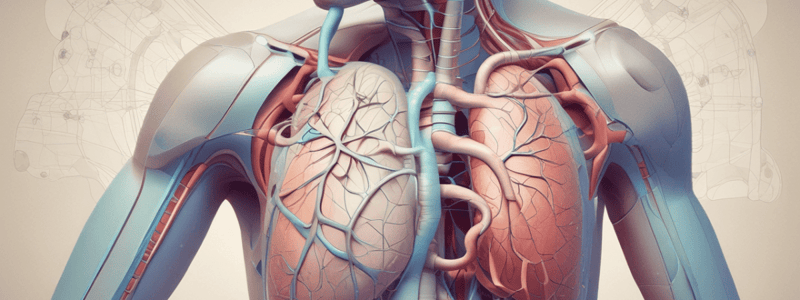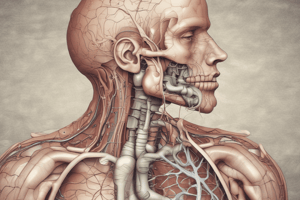Podcast
Questions and Answers
What is the main purpose of using a pattern while assessing lung sounds?
What is the main purpose of using a pattern while assessing lung sounds?
- To ensure you don't miss any areas of the lung (correct)
- To identify the source of adventitious sounds
- To compare lung sounds with those from a previous examination
- To assess the patient's respiratory rate
What type of lung sound is typically loudest over the peripheral lung fields?
What type of lung sound is typically loudest over the peripheral lung fields?
- Bronchial sound
- Bronchovesicular sound
- Vesicular sound (correct)
- Wheeze-sonorous rhonchi
What is the normal range of respiratory rate for an adult?
What is the normal range of respiratory rate for an adult?
- 12-20 breaths per minute (correct)
- 15-25 breaths per minute
- 18-22 breaths per minute
- 10-18 breaths per minute
What type of adventitious sound is characterized by a high-pitched crackling sound?
What type of adventitious sound is characterized by a high-pitched crackling sound?
What is the normal range of arterial oxygen saturation (SPO2) as measured by pulse oximetry?
What is the normal range of arterial oxygen saturation (SPO2) as measured by pulse oximetry?
What is the term for the sound produced by friction in pleural tissue due to inflammation?
What is the term for the sound produced by friction in pleural tissue due to inflammation?
What is the term for an obstruction in the upper airway, often caused by something lodged in the throat, commonly seen in children?
What is the term for an obstruction in the upper airway, often caused by something lodged in the throat, commonly seen in children?
What type of lung sound is typically louder than vesicular sounds and heard closest to the bronchi?
What type of lung sound is typically louder than vesicular sounds and heard closest to the bronchi?
What is the normal respiratory rate in an adult?
What is the normal respiratory rate in an adult?
What is the significance of a patient using accessory muscles of respiration?
What is the significance of a patient using accessory muscles of respiration?
What is the normal finding in a lung examination regarding temperature?
What is the normal finding in a lung examination regarding temperature?
During a lung examination, where should the hands be placed on the mid back?
During a lung examination, where should the hands be placed on the mid back?
What is the normal chest wall configuration in a healthy adult?
What is the normal chest wall configuration in a healthy adult?
What is the significance of clubbing in the nails?
What is the significance of clubbing in the nails?
What is the purpose of the hands moving when the patient is breathing in and out during a lung examination?
What is the purpose of the hands moving when the patient is breathing in and out during a lung examination?
What is the purpose of the patient saying '99, 99' and 'blue moon' during a lung examination?
What is the purpose of the patient saying '99, 99' and 'blue moon' during a lung examination?
What is the significance of a patient sitting in a tripod position?
What is the significance of a patient sitting in a tripod position?
What is the significance of dorsal curvature in the posterior thorax?
What is the significance of dorsal curvature in the posterior thorax?
What should the patient be positioned during a percussion examination?
What should the patient be positioned during a percussion examination?
What is the purpose of palpation in lung assessment?
What is the purpose of palpation in lung assessment?
What is a normal finding during a percussion examination?
What is a normal finding during a percussion examination?
What is the significance of cyanosis in the skin?
What is the significance of cyanosis in the skin?
Why do we hear different sounds when percussing over bones than over lung tissue?
Why do we hear different sounds when percussing over bones than over lung tissue?
How should the patient breathe during an auscultation examination?
How should the patient breathe during an auscultation examination?
What is one of the major functions of respiration?
What is one of the major functions of respiration?
What does the 'A' in ABC stand for?
What does the 'A' in ABC stand for?
When should a patient's lungs be assessed?
When should a patient's lungs be assessed?
What is the ideal position for a patient during lung assessment?
What is the ideal position for a patient during lung assessment?
What is the primary component of a neurologic examination?
What is the primary component of a neurologic examination?
What can cause inaccurate readings in oxygen saturation?
What can cause inaccurate readings in oxygen saturation?
What is the range of scores for the Glasgow Coma Scale?
What is the range of scores for the Glasgow Coma Scale?
What is the primary purpose of percussion of the lungs?
What is the primary purpose of percussion of the lungs?
What is the primary purpose of assessing a patient's level of consciousness?
What is the primary purpose of assessing a patient's level of consciousness?
What type of sound is typically found in healthy lung tissues in an adult?
What type of sound is typically found in healthy lung tissues in an adult?
What is included in the assessment of mental status?
What is included in the assessment of mental status?
What can cause a dull note in lung percussion?
What can cause a dull note in lung percussion?
What is the term for a lower-pitched, booming sound found in lung percussion?
What is the term for a lower-pitched, booming sound found in lung percussion?
What is an indication of underlying disease in lung percussion?
What is an indication of underlying disease in lung percussion?
What is the purpose of auscultating lung sounds in Nursing Anne?
What is the purpose of auscultating lung sounds in Nursing Anne?
What is the appropriate nursing action for abnormal findings in the lungs and thorax exam?
What is the appropriate nursing action for abnormal findings in the lungs and thorax exam?
Flashcards are hidden until you start studying
Study Notes
Assessment of Lungs and Thorax
- Pattern: Important to ensure coverage of all lung fields and to listen to the lateral portion of the lungs (side of body)
Expected Lung Sounds
- Clear lung sounds: Expected normal sound
- No adventitious lung sounds: No crackles or wheezing
- Bronchovesicular sound: Louder than vesicular, heard closest to bronchi, even on inspiration and expiration
- Vesicular sound: Whisper-like sound, louder on inspiration, smaller airway
Adventitious Sounds
- Fine crackles: High-pitched crackling
- Coarse crackles: Fluid in the lungs, sounds like drinking a drink and reaching the bottom
- Pleural friction fremitus: Friction in pleural tissue due to inflammation
- Wheeze-sibilant: Obstruction, air escaping through small airway, narrowed
- Wheeze-sonorous rhonchi: Obstruction, air escaping through small airway, narrowed on exhale
- Stridor: Upper airway obstruction, something lodged in throat, common in children
Respiratory Rate, Rhythm, and Pulse Oximetry
- Respiratory rate and rhythm: Regular, even, effortless, symmetric, consistent, 12-20 breaths per minute
- Pulse oximetry: Noninvasive method to assess arterial oxygen saturation (SPO2), normal values: 97%-99%
Inspection
- Respiratory rate and rhythm: 12-20, consistent, even, regular
- Chest rise and fall: Symmetrical, no accessory muscle use or retractions
- Comfortable positioning: No tripod position, no cyanosis
- Chest wall configuration: Normal: AP:T is 1:2, abnormal: AP:T 1:1, barrel chest, irreversible
- Nails: Abnormal: clubbing caused by chronic hypoxia
- Posterior thorax: Abnormal: asymmetry and dorsal curvature, scoliosis, kyphosis, gibbus
Palpation
- What to feel for: Abnormal findings: crepitus, friction, masses, temperature, normal findings: warm, no masses or tenderness
- Technique: Hands move with breathing starting at T9 vertebrae, go from left to right to down and then right to left motions
- Tactile Fremitus: palpable vibration, sounds generated from larynx, symmetric
Percussion
- Client position: Slightly bent forward
- Compare bilaterally: Note any symmetry, avoid body prominences
- Specific technique: Start at apices and go side-to-side, working way down
- Findings: Normal: resonance (low-pitch, clear, and hollow sound), abnormal: dull, can indicate fluid in lungs, pneumonia, or tumor
Auscultation
- Position: Sit upright, relaxed, hands on knees
- How to breathe: In and out of mouth every time stethoscope makes contact with skin
- How far down to listen: To lateral part of back
- Place on foot (for babies), finger, or toe: Inaccurate readings can be caused by carbon monoxide binding to Hgb instead of oxygen or anemia
Studying That Suits You
Use AI to generate personalized quizzes and flashcards to suit your learning preferences.




